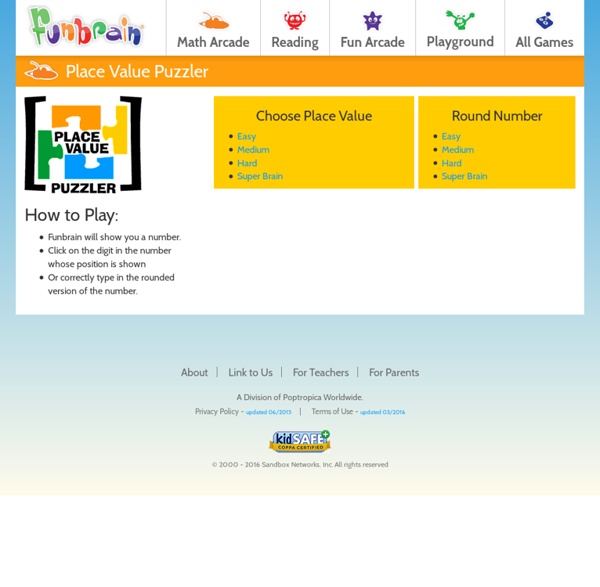



Fun Kids Online Math Games "Sheppard offers everything from early math to pre-algebra. The lessons include interactive activities to practice concepts. Students can shoot fruit, pop balloons, and even play math man (the math version of pac man!). Fractions, place value, money, and basic operations are some of the areas that are covered. Check it out at " --Shannon Jakeman , sjakeman.blogspot.com "Online math games, like the ones that you'll find for free at Sheppard Software, provide a valuable opportunity for children to learn a great deal while they're having fun. It can be very difficult for parents to find productive and worthwhile activities for children on the Internet; however fun online math games do offer a wonderful alternative. This free section of Sheppard Software was written for children. Sheppard Software offers a couple of cute games for the youngest math students.
Free Math Help - Lessons, tutoring, message board and more. Algebra, Geometry, Trig, Calculus... whatever level you're studying! Logic Learning Games For Kids Logic Games Logic Games Kids love to learn with online games. Flash games make it easy for kids to improve their logic skills and analytical reasoning. Logical thinking goes hand in hand with problem solving, both of which are important skills for kids to learn.
Aplusmath.com Popular Cities Kansas City Tutoring Buffalo Tutoring Richmond Tutoring Tulsa Tutoring Denver Tutoring Los Angeles Tutoring Spokane Tutoring Detroit Tutoring Albuquerque Tutoring Memphis Tutoring Popular Subjects Math Tutors in Chicago Reading Tutors in San Diego GRE Tutors in New York City Reading Tutors in Washington DC Computer Science Tutors in Miami Algebra Tutors in New York City French Tutors in Chicago Math Tutors in Phoenix ACT Tutors in San Diego ACT Tutors in Seattle ACT Tutors in Los Angeles MCAT Tutors in Phoenix LSAT Tutors in Phoenix GRE Tutors in Los Angeles Reading Tutors in Atlanta ISEE Tutors in New York City GMAT Tutors in Chicago MCAT Tutors in Atlanta Spanish Tutors in Atlanta SSAT Tutors in Miami Popular Test Prep Call us today to connect with a top tutor Call Now Download our free learning tools apps and test prep books Show More Privacy PolicyTerms of UseSitemapSign In 4.9/5.0 Satisfaction Rating over the last 100,000 sessions.
Addition Math Games - Math Lines 20 Sorry, this is a flash-based game that requires Adobe Flash Player. Many of these games will run on mobile devices with VocabularySpellingCity apps. For Apple devices Available for Android Learn More about www.VocabularySpellingCity.com! Teaching spelling and vocabulary is easy with VocabularySpellingCity! APOLOGIZING Doesnt Mean Buy It with the Little Farmer: a game to learn counting money Buy It with the Little FarmerDevelop money counting skillsPlease be patient while the game loads. Canadian version with the loonie Instructions Pay the little farmer the exact change and he will say 'thank you'. Easy level: The cents portion of the price ranges from 1 to 28 cents.
Cyberchase . Math is Everywhere Come play again later! Come play again tomorrow! Games - Greg Tang Math About Games Our games represent a revolutionary new approach to teaching math that combines common sense, creativity and clever thinking. Focus on Fundamentals. With this in mind, we’ve designed games that teach kids to think about numbers the right way. Us vs Them. Second, our games are full of math - not something else. Timing Is Everything. Level Playing Field. Break Apart These games teach kids the strategies they need for the Common Core's Operations & Algebraic Thinking Standard. Getting Started. Limbo While many games focus on adding numbers, Math Limbo focuses on breaking them apart. Getting Started. Numskill Mastery of basic addition facts is the goal of this game. Getting Started. Expresso Order of operations can be a confusing concept for both kids and adults alike. Getting Started. Missing Funny Numbers Is there an easier way to teach regrouping? Place Value Do kids really understand place value or have they merely memorized by rote the things they know? Standard Algorithms